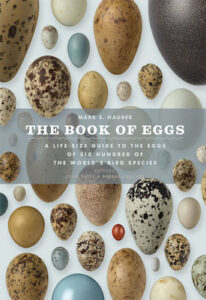Not so very long ago, collecting the eggs of birds was one of the most common activities in the life of budding young naturalists. However with the passage of such foundational conservation legislation as the Lacey and Migratory Bird Treaty Acts – to say nothing of the increasing awareness among many naturalists themselves that all that collecting of eggs may be harming bird populations – the practice of amateur oölogy (the study of eggs) came to an abrupt halt in the early Twentieth Century.
From a conservation perspective this cessation of egg collecting is unquestionably a good thing, but it has produced one unfortunate side-effect: a widespread unfamiliarity with bird eggs among both bird watchers and general naturalists alike. Not only can many if not most of the members of these two respective communities not identify even the most common of wild bird eggs, it is highly likely that they have never even seen any outside of a museum cabinet.
Fortunately, Mark E. Hauber’s recently The Book of Eggs: A Life-Size Guide to the Eggs of Six Hundred of the World’s Bird Species contains much that can help bird watchers and general naturalists alike to rectify their unfamiliarity with bird eggs. Dr. Hauber, a professor in the Animal Behavior and Conservation Program at Hunter College, City University of New York, has collected images of the eggs of six hundred of the world’s bird species and presents them – following a brief but wholly sufficient introduction to the basic biology of bird eggs – in life size and full color with supporting illustrations and text in a manner that is both fascinating as will as informative.
All of the eggs depicted are part of the collections held by either the Field Museum of Natural History in Chicago, Illinois or the Western Foundation of Vertebrate Zoology in Camarillo, California; many of which were, somewhat ironically, originally collected in the late Nineteenth and early Twentieth Centuries by amateur naturalists. Presented one species to a page, each egg is shown both in life size and – if details warrant (as they often do) in magnification so that its texture, pattern, or other pertinent feature might be more easily appreciate by the reader.
Of course, as a collection of nothing but photographs of eggs would, regardless of how colorful or curiously patterned they are, be rather boring, each species entry also contains such useful information as breeding range, clutch size, incubation period, nest type, and even – for those interested in perhaps delving further into the subject – the museum’s collection reference number for the specific egg depicted. Also accompanying each egg are two exceptionally well-written paragraphs which explain some of the more interesting things about it. For example, how the seemingly random dark blotches on the otherwise light greenish-blue eggs of Common Murres is thought to be unique in pattern on each egg, thus helping the parents to identify their eggs among all those they might encounter in the tightly-packed colonial nesting areas where these birds breed.
As might be expected, The Book of Eggs is not a book to be read straight through, cover-to-cover. Once the introductory sections have themselves been read, it is better to peruse it, stopping as the images catch one’s attention, reading about that species, then continuing on to the next in the same manner. This is best done repeatedly, over a span of weeks, after which period the wonders of the amazing variety of shapes, sizes, colors, peculiarities, evolutionary adaptations, and all the other elements that for so long held so many naturalists in thrall to bird eggs will begin to make their charms understood – without, of course, any risk to the bird populations themselves.
 Title: The Book of Eggs: A Life-Size Guide to the Eggs of Six Hundred of the World’s Bird Species
Title: The Book of Eggs: A Life-Size Guide to the Eggs of Six Hundred of the World’s Bird Species
Author: Mark E. Hauber, edited by John Bates and Barbara Becker
Publisher: The University of Chicago Press
Format: Cloth
ISBN: 9780226057781
Pages: 656 pages with 2400 color plates
Price: $55.00
Published: March 2014
A previous edition of this review was published in the March / April 2015 issue of Bird Watcher’s Digest.
In accordance with Federal Trade Commission 16 CFR Part 255, it is disclosed that the copy of the book read in order to produce this review was provided gratis to the reviewer by the publisher
